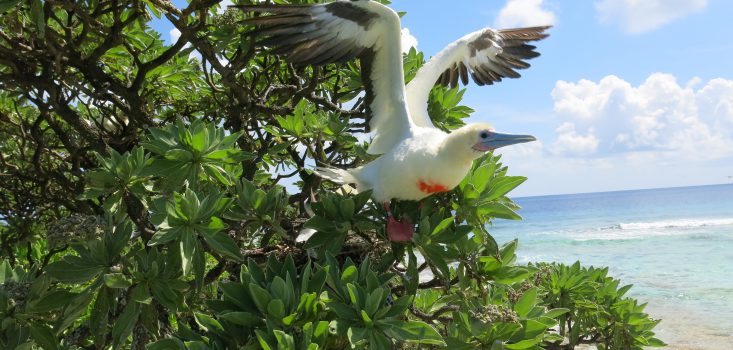At the start of the new year, Peter Carr and Hannah Wood from the Zoological Society of London (ZSL) in collaboration with Exeter University and supported by the Bertarelli Foundation, arrived in the British Indian Ocean Territory (BIOT) to assess the importance of BIOT, and its MPA, for seabirds. An integral part of the Bertarelli Programme in Marine Science, this research will build on work started in 2016 and provide vital information about populations of Red-footed Boobies and other breeding seabirds in this Key Biodiversity Area.
Currently, the researchers are attaching tracking devices to breeding adult Boobies which will, once retrieved, provide information about foraging and breeding behaviours of this iconic species. By unravelling where the birds go, but also why, the scientists will reveal important information about activity ‘hot-spots’ and the health of the ocean upon which they rely.
Malcolm Nicoll, Principal Investigator from the Institute of Zoology at ZSL commented:
It is widely recognised that seabirds are an indicator of ocean health and an important link between the marine and terrestrial environments. Protecting healthy seabird populations is a priority as they bring essential nutrients to islands and their surrounding waters, which can play a positive role in the health of near-shore coral-reefs. As such, research like this which improves our understanding of how large MPAs can benefit seabird populations, will prove vital as we face the growing challenges of global warming and ocean acidification.
The Bertarelli Programme in Marine Science brings together talented scientists from around the world to carry out important research in one of the world’s largest Marine Protected Areas. This large, remote, near pristine, no-take marine reserve presents a unique opportunity to undertake an interdisciplinary approach to understanding the role of these complex ecosystems for mobile species such as tunas, sharks, turtles, and seabirds. As BIOT has been negatively impacted by recent global coral bleaching events, the reserve also provides an important study site to understand the resilience large marine reserves offer in the absence of fishing and other man-made pressures.




